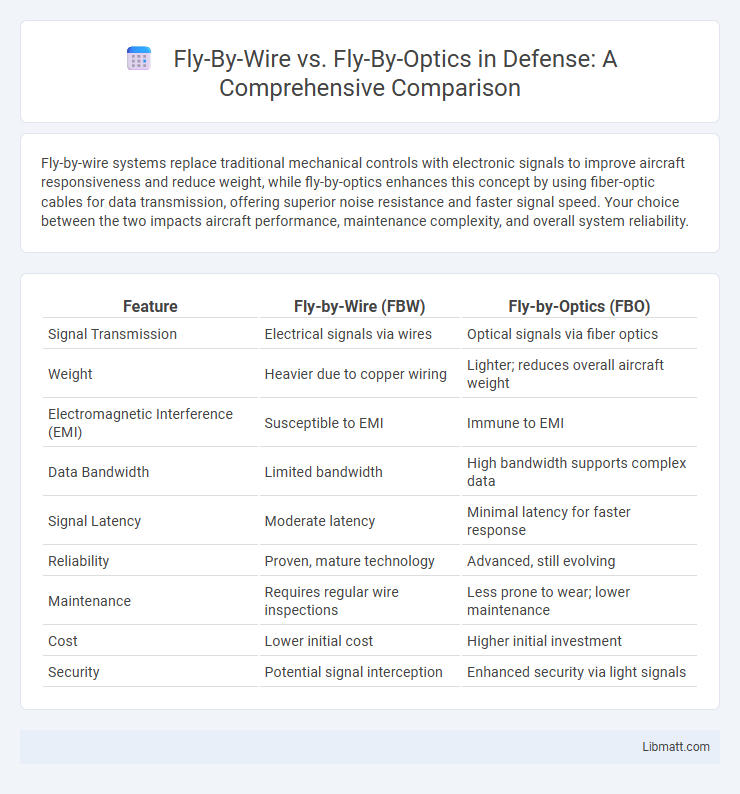Fly-by-wire systems replace traditional mechanical controls with electronic signals to improve aircraft responsiveness and reduce weight, while fly-by-optics enhances this concept by using fiber-optic cables for data transmission, offering superior noise resistance and faster signal speed. Your choice between the two impacts aircraft performance, maintenance complexity, and overall system reliability.
Table of Comparison
| Feature | Fly-by-Wire (FBW) | Fly-by-Optics (FBO) |
|---|---|---|
| Signal Transmission | Electrical signals via wires | Optical signals via fiber optics |
| Weight | Heavier due to copper wiring | Lighter; reduces overall aircraft weight |
| Electromagnetic Interference (EMI) | Susceptible to EMI | Immune to EMI |
| Data Bandwidth | Limited bandwidth | High bandwidth supports complex data |
| Signal Latency | Moderate latency | Minimal latency for faster response |
| Reliability | Proven, mature technology | Advanced, still evolving |
| Maintenance | Requires regular wire inspections | Less prone to wear; lower maintenance |
| Cost | Lower initial cost | Higher initial investment |
| Security | Potential signal interception | Enhanced security via light signals |
Introduction to Flight Control Systems
Flight control systems have evolved from traditional mechanical linkages to advanced fly-by-wire technology, which replaces manual controls with electronic signals for enhanced precision and reliability. Fly-by-optics, an emerging development, uses fiber-optic cables instead of electrical wires to transmit signals, offering benefits like immunity to electromagnetic interference and reduced weight. Your choice between these systems impacts aircraft performance, safety, and maintenance efficiency.
What is Fly-By-Wire?
Fly-By-Wire (FBW) is an advanced flight control system where pilot inputs are converted into electronic signals transmitted by wires, replacing traditional mechanical linkages. This system enhances aircraft responsiveness, stability, and safety by allowing computers to assist in flight control and adjust controls dynamically. FBW technology reduces weight, maintenance, and pilot workload while improving overall aircraft performance.
What is Fly-By-Optics?
Fly-By-Optics is an advanced flight control system that uses fiber optic cables instead of traditional electrical wires to transmit signals between the cockpit and aircraft control surfaces. This technology offers superior resistance to electromagnetic interference, enhanced data transmission speed, and reduced weight compared to conventional Fly-By-Wire systems. By integrating high-bandwidth optical fibers, Fly-By-Optics improves overall aircraft reliability and performance, especially in modern, high-tech aerospace environments.
Key Differences Between Fly-By-Wire and Fly-By-Optics
Fly-by-wire systems utilize electrical signals transmitted through traditional copper wiring to control an aircraft's flight surfaces, while fly-by-optics replace these electrical signals with fiber optic cables, offering faster data transmission and immunity to electromagnetic interference. Fly-by-optics systems provide higher bandwidth and enhanced reliability, making them ideal for advanced avionics and complex flight control requirements. Your aircraft control system's performance and safety can significantly improve by adopting fly-by-optics technology due to its superior signal integrity and reduced weight compared to conventional fly-by-wire setups.
Advantages of Fly-By-Wire Systems
Fly-by-wire systems offer enhanced flight control precision and reduced pilot workload through electronic signal transmission, replacing traditional mechanical linkages. These systems improve aircraft safety by incorporating automatic stability and flight envelope protection, mitigating human error. Additionally, fly-by-wire technology enables weight reduction and easier integration with modern avionics, resulting in increased fuel efficiency and overall performance.
Advantages of Fly-By-Optics Systems
Fly-by-optics systems offer significant advantages over traditional fly-by-wire technology by utilizing fiber optic cables that provide higher bandwidth and immunity to electromagnetic interference, ensuring more reliable and faster signal transmission. These systems enhance aircraft performance through reduced weight and improved data integrity, leading to increased fuel efficiency and lower maintenance costs. Your aircraft benefits from superior control precision and enhanced safety, thanks to the advanced fault tolerance and real-time diagnostics inherent in fly-by-optics technology.
Limitations and Challenges of Each System
Fly-by-wire systems face limitations such as susceptibility to electromagnetic interference and latency issues that can affect real-time control responsiveness. Fly-by-optics, while offering enhanced immunity to electromagnetic disturbances and increased data transmission speed, encounter challenges related to the fragility of fiber optic cables and higher installation and maintenance costs. Your choice between these systems should consider operational environment, reliability needs, and budget constraints.
Applications in Modern Aircraft
Fly-by-wire systems are widely implemented in modern commercial and military aircraft, providing enhanced flight control precision through electronic signals that replace traditional mechanical linkages. Fly-by-optics, an advanced evolution, leverages fiber optic cables for data transmission, offering superior immunity to electromagnetic interference and reduced weight, which is critical in high-performance fighter jets and next-generation airliners. Both technologies contribute to improved safety, responsiveness, and fuel efficiency by enabling real-time data processing and integration with automated flight systems.
Future Trends in Flight Control Technology
Fly-by-optics systems represent the future of flight control technology, offering enhanced data transmission speeds, immunity to electromagnetic interference, and reduced weight compared to traditional fly-by-wire systems that rely on electrical signals and copper wiring. Emerging trends emphasize integrating fiber optic networks with advanced sensor fusion and AI-driven control algorithms to improve flight safety, responsiveness, and reliability. The shift towards fly-by-optics is driven by the demand for higher bandwidth communication and robustness in increasingly complex avionics architectures for next-generation aircraft.
Conclusion: Choosing the Right Flight Control System
Fly-by-wire systems utilize electrical signals for precise aircraft control, offering weight reduction and improved reliability, while fly-by-optics introduces fiber optic cables that enhance data transmission speed and immunity to electromagnetic interference. Your choice between these technologies depends on factors such as aircraft complexity, sensitivity to environmental disturbances, and maintenance capabilities. Selecting the right flight control system ensures optimal performance, safety, and operational efficiency tailored to your specific aviation needs.
fly-by-wire vs fly-by-optics Infographic

 libmatt.com
libmatt.com